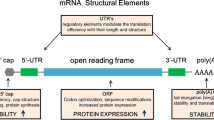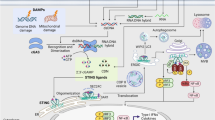Abstract
Interleukin-4 is a signature cytokine of T-helper type 2 (Th2) cells that play a major role in shaping immune responses. Its role in highly relevant animal model of tuberculosis (TB) like guinea pig has not been studied till date. In the current study, the guinea pig IL-4 gene was cloned and expressed using a prokaryotic expression vector (pET30 a(+)). This approach yielded a recombinant protein of 19 kDa as confirmed by mass spectrometry analysis and named as recombinant guinea pig (rgp)IL-4 protein. The authenticity of the expression of rgpIL-4 protein was further verified through polyclonal anti-IL4 antiserum raised in rabbits that showed specific and strong binding with the recombinant protein. The biological activity of the rgpIL-4 was ascertained in RAW264.7 cells where LPS-treated nitric oxide (NO) production was found to be suppressed in the presence of this protein. The three-dimensional structure of guinea pig IL-4 was predicted by utilizing the template structure of human interleukin-4, which shared a sequence homology of 58%. The homology modeling result showed clear resemblance of guinea pig IL-4 structure with the human IL-4. Taken together, our study indicates that the newly expressed, biologically active rgpIL-4 protein could provide deeper understanding of the immune responses in guinea pig to different infectious diseases like TB and non-infectious ones.




Similar content being viewed by others
References
Global tuberculosis report. (2018). World health organization: Global tuberculosis control. Geneva: WHO.
Roy, A., Eisenhut, M., Harris, R. J., Rodrigues, L. C., Sridhar, S., Habermann, S., et al. (2014). Effect of BCG vaccination against Mycobacterium tuberculosis infection in children: Systematic review and meta-analysis. The BMJ,2014, 349.
Chang, K. C., & Leung, C. C. (2017). BCG Immunization: Efficacy, limitations, and future needs. In Y. Lu, L. Wang, H. Duanmu, C. Chanyasulkit, A. Strong, & H. Zhang (Eds.), Handbook of global tuberculosis control. Boston, MA: Springer.
Ordway, D., Palanisamy, G., Henao-Tamayo, M., Smith, E. E., Shanley, C., Orme, I. M., et al. (2007). The cellular immune response to Mycobacterium tuberculosis infection in the guinea pig. Journal of Immunology,179, 2532–2541.
McMurray, D. N. (2016). Animal models of tuberculosis. In A. J. Hickey, A. Misra, & P. B. Fourie (Eds.), Drug delivery systems for tuberculosis prevention and treatment. Hoboken: Wiley.
Clark, S., Hall, Y., & Williams, A. (2015). Animal models of tuberculosis: Guinea pigs. Cold Spring Harbor Perspectives in Medicine,5, 018572.
Lyons, M. J., Yoshimura, T., & McMurray, D. N. (2002). Mycobacterium bovis BCG vaccination augments interleukin-8 mRNA expression and protein production in guinea pig alveolar macrophages infected with Mycobacterium tuberculosis. Infection and Immunity,70, 5471–5478.
Skwor, T. A., Cho, H., Cassidy, C., Yoshimura, T., & McMurray, D. N. (2004). Recombinant guinea pig CCL5 (RANTES) differentially modulates cytokine production in alveolar and peritoneal macrophages. Journal of Leukocytic Biology,76, 1229–1239.
Lasco, T. M., Cassone, L., Kamohara, H., Yoshimura, T., & McMurray, D. N. (2005). Evaluating the role of tumor necrosis factor-alpha in experimental pulmonary tuberculosis in the guinea pig. Tuberculosis,85, 245–258.
Dirisala, V. R., Jeevan, A., Ly, L. H., & McMurray, D. N. (2015). Molecular and biochemical characterization of recombinant guinea pig tumor necrosis factor-alpha. Mediators of Inflammation. https://doi.org/10.1155/2015/619480.
Jeevan, A., McFarland, C. T., Yoshimura, T., Skwor, T., Cho, H., Lasco, T., et al. (2006). Production and characterization of guinea pig recombinant gamma interferon and its effect on macrophage activation. Infection and Immunity,74, 213–224.
Dirisala, V. R., Jeevan, A., Bix, G., Yoshimura, T., & McMurray, D. N. (2012). Molecular cloning and expression of the IL-10 gene from guinea pigs. Gene,498, 120–127.
Dirisala, V. R., Jeevan, A., Ly, L. H., & McMurray, D. N. (2013). Prokaryotic expression and in vitro functional analysis of IL-1β and MCP-1 from guinea pig. Molecular Biotechnology,54, 312–319.
Dirisala, V. R., Jeevan, A., Ly, L. H., & McMurray, D. N. (2013). Molecular cloning, expression and in silico structural analysis of guinea pig IL-17. Molecular Biotechnology,55, 277–287.
Urdahl, K. B., Shafiani, S., & Ernst, J. D. (2011). Initiation and regulation of T-cell responses in tuberculosis. Mucosal Immunology,4, 288–293.
Zuniga, J., Torres-Garcia, D., Santos-Mendoza, T., Rodriguez-Reyna, T. S., Granados, J., & Yunis, E. J. (2012). Cellular and humoral mechanisms involved in the control of tuberculosis. Clinical and Developmental Immunology. https://doi.org/10.1155/2012/193923.
Nolan, A., Fajardo, E., Huie, M. L., Condos, R., Pooran, A., Dawson, R., et al. (2013). Increased production of IL-4 and IL-12p40 from bronchoalveolar lavage cells are biomarkers of Mycobacterium tuberculosis in the sputum. PLoS ONE,8, 59461.
Mihret, A., Bekele, Y., Loxton, A. G., Aseffa, A., Howe, R., & Walzl, G. (2012). Plasma level of IL-4 differs in patients infected with different modern lineages of M. tuberculosis. Journal of Tropical Medicine. https://doi.org/10.1155/2012/518564.
Lienhardt, C., Azurri, A., Amedei, A., Fielding, K., Sillah, J., Sow, O. Y., et al. (2002). Active tuberculosis in Africa is associated with reduced Th1 and increased Th2 activity in vivo. European Journal of Immunology,32, 1605–1613.
Jeevan, A., Yoshimura, T., Ly, L. H., Dirisala, V. R., & McMurray, D. N. (2011). Cloning and characterization of guinea pig interleukin-4: Reduced IL-4 mRNA after vaccination or Mycobacterium tuberculosis infection. Tuberculosis,91, 47–56.
Hiroi, M., Sakaeda, Y., Yamaguchi, H., & Ohmori, Y. (2013). Anti-inflammatory cytokine interleukin-4 inhibits inducible nitric oxide synthase gene expression in the mouse macrophage cell line RAW264.7 through the repression of octamer-dependent transcription. Mediators of Inflammation. https://doi.org/10.1155/2013/369693.
Rishi, L., Dhiman, R., Raje, M., & Majumdar, S. (2007). Nitric oxide induces apoptosis in cutaneous T-cell lymphomas (HuT-78) by downregulating constituting NF-KB. Biochimica et Biophysica Acta,1770, 1230–1239.
Yang, J., & Yang, Z. (2015). Protein structure and function prediction using I‐TASSER. Current Protocols in Bioinformatics,52, 5–8.
Wan, Y. Y., & Flavell, R. A. (2009). How diverse-CD4 effector T cells and their functions. Journal of Molecular Cell Biology,1, 20–36.
Van Dyken, S. J., & Locksley, R. M. (2013). Interleukin-4-and interleukin-13-mediated alternatively activated macrophages: roles in homeostasis and disease. Annual Review of Immunology,31, 317–343.
Lugo-Villarino, G., Vérollet, C., Maridonneau-Parini, I., & Neyrolles, O. (2011). Macrophage polarization: Convergence point targeted by Mycobacterium tuberculosis and HIV. Frontiers in Immunology,2, 43.
Romero-Adrian, T., Leal-Montiel, J., Fernández, G., & Valecillo, A. (2015). Role of cytokines and other factors involved in the Mycobacterium tuberculosis infection. World Journal of Immunology,5, 16–50.
Nolan, A., Fajardo, E., Huie, M. L., Condos, R., Pooran, A., Dawson, R., et al. (2013). Increased production of IL-4 and IL-12p40 from bronchoalveolar lavage cells are biomarkers of Mycobacterium tuberculosis in the sputum. PLoS ONE,8, e59461.
Manca, C., Reed, M. B., Freeman, S., Mathema, B., Kreiswirth, B., Barry, C. E., 3rd, et al. (2004). Differential monocyte activation underlies strain-specific Mycobacterium tuberculosis pathogenesis. Infection and Immunity,72, 5511–5514.
Rook, G. A., Hernandez-Pando, R., Dheda, K., & Teng Seah, G. (2004). IL-4 in tuberculosis: Implications for vaccine design. Trends in Immunology,25, 483–488.
Guler, R., Parihar, S. P., Savvi, S., Logan, E., Schwegmann, A., Roy, S., et al. (2015). IL-4Rα-dependent alternative activation of macrophages is not decisive for Mycobacterium tuberculosis pathology and bacterial burden in mice. PLoS ONE,10, e0121070.
Lindblad, E. B., Elhay, M. J., Silva, R., Appelberg, R., & Andersen, P. (1997). Adjuvant modulation of immune responses to tuberculosis subunit vaccines. Infection and Immunity,65, 623–629.
Hernandez-Pando, R., Pavön, L., Arriaga, K., Orozco, H., Madrid-Marina, V., & Rook, G. (1997). Pathogenesis of tuberculosis in mice exposed to low and high doses of an environmental mycobacterial saprophyte before infection. Infection and Immunity,65, 3317–3327.
Wangoo, A., Sparer, T., Brown, I. N., Snewin, V. A., Janssen, R., Thole, J., et al. (2001). Contribution of Th1 and Th2 cells to protection and pathology in experimental models of granulomatous lung disease. The Journal of Immunology,166, 3432–3439.
Hernandez-Pando, R., Pavön, L., Arriaga, K., Orozco, H., Madrid-Marina, V., & Rook, G. (2004). Pulmonary tuberculosis in BALB/c mice with non-functional IL-4 genes: changes in the inflammatory effects of TNF-α and in the regulation of fibrosis. European Journal of Immunology,34, 174–183.
Tamgue, O., Gcanga, L., Ozturk, M., Whitehead, L., Pillay, S., Jacobs, R., et al. (2019). Differential targeting of c-Maf, Bach-1, and Elmo-1 by microRNA-143 and microRNA-365 promotes the intracellular growth of Mycobacterium tuberculosis in alternatively IL-4/IL-13 activated macrophages. Frontiers in Immunology,10, 421.
Pooran, A., Davids, M., Nel, A., Shoko, A., Blackburn, J., & Dheda, K. (2019). IL-4 subverts mycobacterial containment in M. tuberculosis-infected human macrophages. European Respiratory Journal. https://doi.org/10.1183/13993003.02242-2018.
Buccheri, S., Reljic, R., Caccamo, N., Ivanyi, J., Singh, M., Salerno, A., et al. (2007). IL-4 depletion enhances host resistance and passive IgA protection against tuberculosis infection in BALB/c mice. European Journal of Immunology,37, 729–737.
Ly, L. H., Jeevan, A., & McMurray, D. N. (2009). Neutralization of TNFα alters inflammation in guinea pig Tuberculous pleuritis. Microbes and Infection,11, 680–688.
Mitchell, L. C., David, L. A., & Lipsky, P. E. (1989). Promotion of human T lymphocyte proliferation by IL-4. Journal of Immunology,142, 1548.
Ly, L. H., Russell, M. I., & McMurray, D. N. (2008). Cytokine profiles in primary and secondary pulmonary granulomas of guinea pigs with tuberculosis. American Journal of Respiratory and Cellular Molecular Biology,38, 455–462.
Chu, C., Zhang, W., Li, J., Wan, Y., Wang, Z., Duan, R., et al. (2018). A single codon optimization enhances recombinant human TNF-α vaccine expression in Escherichia coli. BioMed Research International. https://doi.org/10.1155/2018/3025169.
Kaur, J., Kumar, A., & Kaur, J. (2018). Strategies for optimization of heterologous protein expression in E. coli: Roadblocks and reinforcements. International Journal of Biological Macromolecules,106, 803–822.
Dirisala, V. R., Nair, R. R., Rao, K. R. S. S., Krupanidhi, S., & Giridhar, P. (2017). Recombinant pharmaceutical protein production in plants: Unraveling the therapeutic potential of molecular farming. Acta Physiologiae Plantarum,39, 18. https://doi.org/10.1007/s11738-016-2315-3
Acknowledgements
The authors thank Vignan’s University for providing facilities under FIST to execute this work. The authors also thank NIT, Rourkela for providing facilities to execute some of the experiments. The authors acknowledge the support of SERB (ECR/2016/00304). We also thank the anonymous reviewers for their comments which helped us in improving the quality of the manuscript.
Author information
Authors and Affiliations
Corresponding author
Additional information
Publisher's Note
Springer Nature remains neutral with regard to jurisdictional claims in published maps and institutional affiliations.
Electronic supplementary material
Below is the link to the electronic supplementary material.
Supplementary material 1 (PPTX 344 kb)
Supplementary figure 1. Structural validation of SAVES server. Figure (a) shows the Ramachandran plot for the predicted structure. (b) PROVE server showing the atomic resolution and (c) ERRAT2 score showing the overall quality factor. Supplementary figure 2. RAW264.7 cells were seeded overnight and stimulated next day with either LPS (10 µg/ml) or left alone for 48 h. Some of the combinations were pretreated with either rgpIL-4 protein or rgpIL-4 protein generated using codon-optimized IL-4 gene for 1 h before adding LPS. The nitrite assay was performed in harvested supernatants using Griess reagent as described in Materials and Methods. The data shown represent values of 3 independent experiments and are represented as Mean ± SEM. ** denotes p < 0.01 and * denotes p < 0.05.
Rights and permissions
About this article
Cite this article
Omanakuttan, M., Konatham, H.R., Dirisala, V.R. et al. Prokaryotic Expression, In Vitro Biological Analysis, and In Silico Structural Evaluation of Guinea Pig IL-4. Mol Biotechnol 62, 104–110 (2020). https://doi.org/10.1007/s12033-019-00227-w
Published:
Issue Date:
DOI: https://doi.org/10.1007/s12033-019-00227-w




